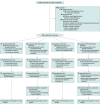Effect of Motor Skill Training in Functional Activities vs Strength and Flexibility Exercise on Function in People With Chronic Low Back Pain: A Randomized Clinical Trial
- PMID: 33369625
- PMCID: PMC7770617
- DOI: 10.1001/jamaneurol.2020.4821
Effect of Motor Skill Training in Functional Activities vs Strength and Flexibility Exercise on Function in People With Chronic Low Back Pain: A Randomized Clinical Trial
Erratum in
-
Error in Figure and Table.JAMA Neurol. 2021 Apr 1;78(4):497. doi: 10.1001/jamaneurol.2020.5321. JAMA Neurol. 2021. PMID: 33464301 Free PMC article. No abstract available.
Abstract
Importance: Chronic low back pain (LBP) is the most prevalent chronic pain in adults, and there is no optimal nonpharmacologic management. Exercise is recommended, but no specific exercise-based treatment has been found to be most effective.
Objective: To determine whether an exercise-based treatment of person-specific motor skill training (MST) in performance of functional activities is more effective in improving function than strength and flexibility exercise (SFE) immediately, 6 months, and 12 months following treatment. The effect of booster treatments 6 months following treatment also was examined.
Design, setting, and participants: In this single-blind, randomized clinical trial of people with chronic, nonspecific LBP with 12-month follow-up, recruitment spanned December 2013 to August 2016 (final follow-up, November 2017), and testing and treatment were performed at an academic medical center. Recruitment was conducted by way of flyers, physician and physical therapy offices, advertisements, and media interviews at Washington University in St Louis, Missouri. Of 1595 adults screened for eligibility, 1301 did not meet the inclusion criteria and 140 could not be scheduled for the first visit. A total of 154 people with at least 12 months of chronic, nonspecific LBP, aged 18 to 60 years, with modified Oswestry Disability Questionnaire (MODQ) score of at least 20% were randomized to either MST or SFE. Data were analyzed between December 1, 2017, and October 6, 2020.
Interventions: Participants received 6 weekly 1-hour sessions of MST in functional activity performance or SFE of the trunk and lower limbs. Half of the participants in each group received up to 3 booster treatments 6 months following treatment.
Main outcomes and measures: The primary outcome was the modified Oswestry Disability Questionnaire (MODQ) score (0%-100%) evaluated immediately, 6 months, and 12 months following treatment.
Results: A total of 149 participants (91 women; mean [SD] age, 42.5 [11.7] years) received some treatment and were included in the intention-to-treat analysis. Following treatment, MODQ scores were lower for MST than SFE by 7.9 (95% CI, 4.7 to 11.0; P < .001). During the follow-up phase, the MST group maintained lower MODQ scores than the SFE group, 5.6 lower at 6 months (95% CI, 2.1 to 9.1) and 5.7 lower at 12 months (95% CI, 2.2 to 9.1). Booster sessions did not change MODQ scores in either treatment.
Conclusions and relevance: People with chronic LBP who received MST had greater short-term and long-term improvements in function than those who received SFE. Person-specific MST in functional activities limited owing to LBP should be considered in the treatment of people with chronic LBP.
Trial registration: ClinicalTrials.gov Identifier: NCT02027623.
Conflict of interest statement
Figures


References
-
- Pizzo PA, Clark NM, Carter-Pokras O, et al. . Relieving Pain in America: A Blueprint for Transforming Prevention, Care, Education, and Research. Washington, DC: 2011.
Publication types
MeSH terms
Associated data
Grants and funding
LinkOut - more resources
Full Text Sources
Medical
Miscellaneous

